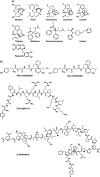The effects of opioids and opioid analogs on animal and human endocrine systems
- PMID: 19903933
- PMCID: PMC2852206
- DOI: 10.1210/er.2009-0009
The effects of opioids and opioid analogs on animal and human endocrine systems
Abstract
Opioid abuse has increased in the last decade, primarily as a result of increased access to prescription opioids. Physicians are also increasingly administering opioid analgesics for noncancer chronic pain. Thus, knowledge of the long-term consequences of opioid use/abuse has important implications for fully evaluating the clinical usefulness of opioid medications. Many studies have examined the effect of opioids on the endocrine system; however, a systematic review of the endocrine actions of opioids in both humans and animals has, to our knowledge, not been published since 1984. Thus, we reviewed the literature on the effect of opioids on the endocrine system. We included both acute and chronic effects of opioids, with the majority of the studies done on the acute effects although chronic effects are more physiologically relevant. In humans and laboratory animals, opioids generally increase GH and prolactin and decrease LH, testosterone, estradiol, and oxytocin. In humans, opioids increase TSH, whereas in rodents, TSH is decreased. In both rodents and humans, the reports of effects of opioids on arginine vasopressin and ACTH are conflicting. Opioids act preferentially at different receptor sites leading to stimulatory or inhibitory effects on hormone release. Increasing opioid abuse primarily leads to hypogonadism but may also affect the secretion of other pituitary hormones. The potential consequences of hypogonadism include decreased libido and erectile dysfunction in men, oligomenorrhea or amenorrhea in women, and bone loss or infertility in both sexes. Opioids may increase or decrease food intake, depending on the type of opioid and the duration of action. Additionally, opioids may act through the sympathetic nervous system to cause hyperglycemia and impaired insulin secretion. In this review, recent information regarding endocrine disorders among opioid abusers is presented.
Figures
References
-
- National Institute on Drug Abuse 2008 Clinical trials network— research. Retrieved July 22, 2009. http://www.nida.nih.gov/CTN/Research.html
-
- Hoffmann NG, Olofsson O, Salen B, Wickstrom L 1995 Prevalence of abuse and dependency in chronic pain patients. Int J Addict 30:919–927 - PubMed
-
- Manchikanti L 2007 National drug control policy and prescription drug abuse: facts and fallacies. Pain Physician 10:399–424 - PubMed
-
- 2007 The NSDUH Report: patterns and trends in nonmedical prescription pain reliever use 2002 to 2005. Rockville, MD: Substance Abuse and Mental Health Services Administration
-
- Johnston LD, O'Malley PM, Bachman JG, Schulenberg JE 2008 Monitoring the future national results on adolescent drug use: overview of key findings, 2007. Bethesda, MD: National Institute on Drug Abuse
Publication types
MeSH terms
Substances
Grants and funding
- U54 HD41748/HD/NICHD NIH HHS/United States
- R01 DA016682/DA/NIDA NIH HHS/United States
- G21 RR03026/RR/NCRR NIH HHS/United States
- R01 DA014659/DA/NIDA NIH HHS/United States
- R01 DA14659/DA/NIDA NIH HHS/United States
- R01 DA021274/DA/NIDA NIH HHS/United States
- R01 DA16682/DA/NIDA NIH HHS/United States
- U54 HD041748/HD/NICHD NIH HHS/United States
- U54 RR14616/RR/NCRR NIH HHS/United States
- G12 RR003026/RR/NCRR NIH HHS/United States
- U54 RR014616/RR/NCRR NIH HHS/United States
- R25 DA033613/DA/NIDA NIH HHS/United States
- R24 DA017298/DA/NIDA NIH HHS/United States
LinkOut - more resources
Full Text Sources
Other Literature Sources
Medical



